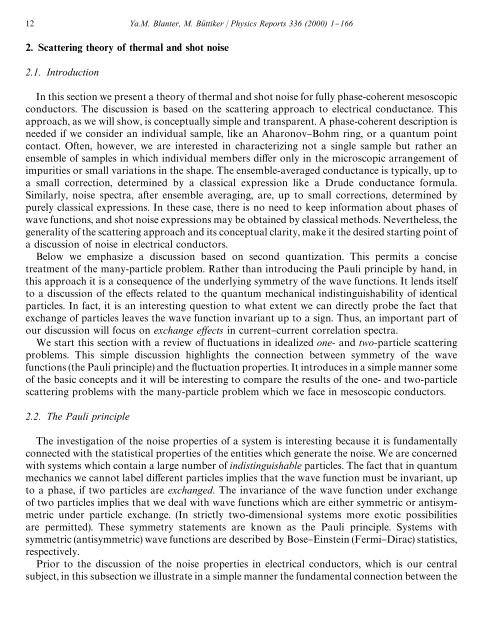shot noise in mesoscopic conductors - Low Temperature Laboratory
shot noise in mesoscopic conductors - Low Temperature Laboratory
shot noise in mesoscopic conductors - Low Temperature Laboratory
You also want an ePaper? Increase the reach of your titles
YUMPU automatically turns print PDFs into web optimized ePapers that Google loves.
12 Ya.M. Blanter, M. Bu( ttiker / Physics Reports 336 (2000) 1}166<br />
2. Scatter<strong>in</strong>g theory of thermal and <strong>shot</strong> <strong>noise</strong><br />
2.1. Introduction<br />
In this section we present a theory of thermal and <strong>shot</strong> <strong>noise</strong> for fully phase-coherent <strong>mesoscopic</strong><br />
<strong>conductors</strong>. The discussion is based on the scatter<strong>in</strong>g approach to electrical conductance. This<br />
approach, as we will show, is conceptually simple and transparent. A phase-coherent description is<br />
needed if we consider an <strong>in</strong>dividual sample, like an Aharonov}Bohm r<strong>in</strong>g, or a quantum po<strong>in</strong>t<br />
contact. Often, however, we are <strong>in</strong>terested <strong>in</strong> characteriz<strong>in</strong>g not a s<strong>in</strong>gle sample but rather an<br />
ensemble of samples <strong>in</strong> which <strong>in</strong>dividual members di!er only <strong>in</strong> the microscopic arrangement of<br />
impurities or small variations <strong>in</strong> the shape. The ensemble-averaged conductance is typically, up to<br />
a small correction, determ<strong>in</strong>ed by a classical expression like a Drude conductance formula.<br />
Similarly, <strong>noise</strong> spectra, after ensemble averag<strong>in</strong>g, are, up to small corrections, determ<strong>in</strong>ed by<br />
purely classical expressions. In these case, there is no need to keep <strong>in</strong>formation about phases of<br />
wave functions, and <strong>shot</strong> <strong>noise</strong> expressions may be obta<strong>in</strong>ed by classical methods. Nevertheless, the<br />
generality of the scatter<strong>in</strong>g approach and its conceptual clarity, make it the desired start<strong>in</strong>g po<strong>in</strong>t of<br />
a discussion of <strong>noise</strong> <strong>in</strong> electrical <strong>conductors</strong>.<br />
Below we emphasize a discussion based on second quantization. This permits a concise<br />
treatment of the many-particle problem. Rather than <strong>in</strong>troduc<strong>in</strong>g the Pauli pr<strong>in</strong>ciple by hand, <strong>in</strong><br />
this approach it is a consequence of the underly<strong>in</strong>g symmetry of the wave functions. It lends itself<br />
to a discussion of the e!ects related to the quantum mechanical <strong>in</strong>dist<strong>in</strong>guishability of identical<br />
particles. In fact, it is an <strong>in</strong>terest<strong>in</strong>g question to what extent we can directly probe the fact that<br />
exchange of particles leaves the wave function <strong>in</strong>variant up to a sign. Thus, an important part of<br />
our discussion will focus on exchange ewects <strong>in</strong> current}current correlation spectra.<br />
We start this section with a review of #uctuations <strong>in</strong> idealized one- and two-particle scatter<strong>in</strong>g<br />
problems. This simple discussion highlights the connection between symmetry of the wave<br />
functions (the Pauli pr<strong>in</strong>ciple) and the #uctuation properties. It <strong>in</strong>troduces <strong>in</strong> a simple manner some<br />
of the basic concepts and it will be <strong>in</strong>terest<strong>in</strong>g to compare the results of the one- and two-particle<br />
scatter<strong>in</strong>g problems with the many-particle problem which we face <strong>in</strong> <strong>mesoscopic</strong> <strong>conductors</strong>.<br />
2.2. The Pauli pr<strong>in</strong>ciple<br />
The <strong>in</strong>vestigation of the <strong>noise</strong> properties of a system is <strong>in</strong>terest<strong>in</strong>g because it is fundamentally<br />
connected with the statistical properties of the entities which generate the <strong>noise</strong>. We are concerned<br />
with systems which conta<strong>in</strong> a large number of <strong>in</strong>dist<strong>in</strong>guishable particles. The fact that <strong>in</strong> quantum<br />
mechanics we cannot label di!erent particles implies that the wave function must be <strong>in</strong>variant, up<br />
to a phase, if two particles are exchanged. The <strong>in</strong>variance of the wave function under exchange<br />
of two particles implies that we deal with wave functions which are either symmetric or antisymmetric<br />
under particle exchange. (In strictly two-dimensional systems more exotic possibilities<br />
are permitted). These symmetry statements are known as the Pauli pr<strong>in</strong>ciple. Systems with<br />
symmetric (antisymmetric) wave functions are described by Bose}E<strong>in</strong>ste<strong>in</strong> (Fermi}Dirac) statistics,<br />
respectively.<br />
Prior to the discussion of the <strong>noise</strong> properties <strong>in</strong> electrical <strong>conductors</strong>, which is our central<br />
subject, <strong>in</strong> this subsection we illustrate <strong>in</strong> a simple manner the fundamental connection between the
















